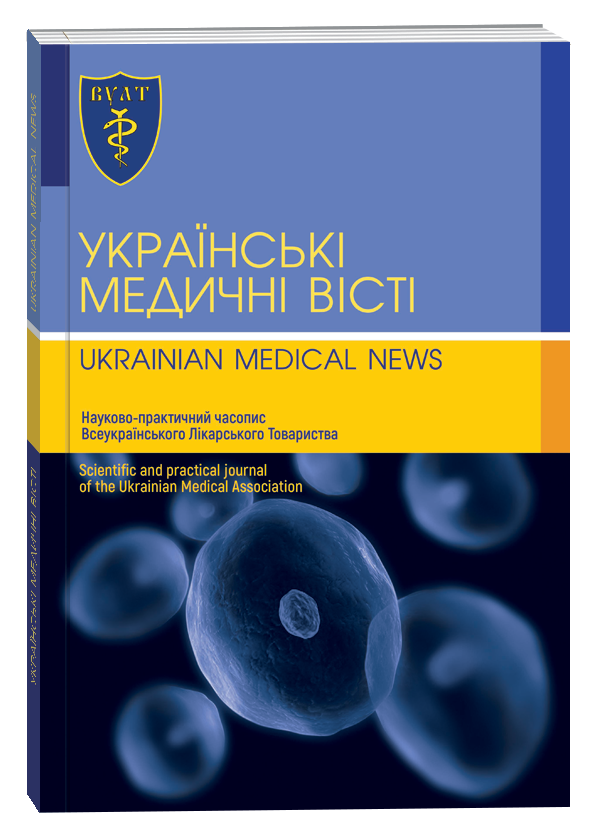EXOSOMES MOLECULAR PATHWAYS OF ACTION AND PHARMACOLOGICAL POTENTIAL IN REGENERATIVE MEDICINE (LITERATURE REVIEW)
DOI:
https://doi.org/10.32782/umv-2025.1.15Keywords:
exosomes, extracellular vesicles, fibroblasts, skin photoaging, skin rejuvenation, mesenchymal stem cellsAbstract
The article examines the theoretical and methodological principles of the mechanisms of influence of exosome, are released into the extracellular space by exocytosis, and play a key role in intercellular signaling. Due to their ability to transport bioactive molecules such as mRNAs, microRNAs, proteins, lipids, and metabolites, exosomes regulate the cellular microenvironment, immune response, angiogenesis, peroxidation, proliferation, and repair processes. Their effect on dermal fibroblasts, keratocytes, and melanocytes creates new opportunities for tissue regeneration, extracellular matrix synthesis activation, and photoinduced and chronically induced skin aging correction. Due to this, exosomes are of great interest in all fields of medicine.The purpose of the study is to investigate and summarize current information on the therapeutic and regenerative potential of exosomes based on open sources of information and to improve further research in this area.Materials and methods. The publications were selected according to databases of Ukrainian and European publishers, which cover information on using exosomes in various fields of medicine and aesthetic cosmetology.The materials were studied in three stages. In the first stage, we searched the literature using the keywords exosomes.In the second stage, we studied the abstracts of the articles and excluded publications that did not meet the criteria of the study. In the third stage, we studied the full texts of the selected articles and met the criteria for inclusion in the list of references and studies.Results and discussion. The article reviews and analyzes the current biotechnological possibilities of using exosomes to treat damaged tissues and rejuvenate the skin. Their effect on keratocytes, fibroblast proliferation and migration, melanogenesis, collagen stimulation, chronic inflammation, oxidative stress, and several other structures and functions is discussed step by step. Particular attention is drawn to their ability to transport biologically active molecules into target cells, stimulating natural regeneration and inhibiting skin photoaging.Conducting a theoretical analysis of this issue, our attention was drawn to exosomes derived from multipotent cells induced by human dermal fibroblasts, Hanheal products, presented by PlatinumMed, which makes it possible to avoid ethical problems in further research and immune rejection, as they are derived from the patient’s tissues, which makes them safe. These products are a revolutionary breakthrough in modern cosmetology and regenerative medicine. The use of advanced biotechnological methods that ensure the stability of exosomes and reduce the risk of contamination with foreign proteins or other biomolecules guarantees a high degree of purity, and the poly- component nature of the lyophilizer further enhances the multifunctional effect and bioactivity of the drug.Conclusions. Exosomes are universal carriers of bioactive molecules, and the cells that secrete them play a key role in regulating various physiological and pathological processes. Understanding the specifics of exosomes of each cell type opens up broad prospects for their use in therapy, aesthetic medicine, diagnostics, and bioengineering.To summarize the positive and negative aspects and to ensure the availability and safety of Hanheal exosome-based products presented by PlatinumMed, the theoretical analysis needs to be proven in practice, so, the next step is to conduct a scientific study with these products.
References
1. Музиченко ПФ, Черняк ВА, Шевченко ОО, Левон ММ. Перспективи застосування екзосом у клінічній практиці. 2019; Том 20. № 5. doi: 10.22141/1608 1706.5.20.2019.185561.
2. Muzychenko P.F., Chernyak V.A., Shevchenko O.O., Levon M.M. Prospects for the use of exosomes in clinical practice for a practicing physician. 2019; Volume 20, No. 5. doi: 10.22141/16081706.5.20.2019.185561 (in Ukrainian).
3. Ansary TM, Hossain MR, Kamiya K, Komine M, Ohtsuki M. Inflammatory Molecules Associated with Ultraviolet Radiation-Mediated Skin Aging. Int J Mol Sci. 2021 Apr; 12;22(8):3974. doi: 10.3390/ijms22083974.
4. Bae Y-U, Son Y, Kim C-H, Kim KS, Hyun SH, Woo HG, Jee BA, Choi J-H, Sung H-K, Choi H-C. mmu-miR- 291a-3p, Embryonic Stem Cell-Derived mmu-miR-291a-3p Inhibits Cellular Senescence in Human Dermal Fibroblasts Through the TGF-β Receptor 2 Pathway. J Gerontol А. 2019; 74(9):1359–1367. doi: 10.1093/gerona/gly208.
5. Cao J, et al. Developing standards to support the clinical translation of stem cells. Stem Cells Transl. Med. 2021; 10:S85–S95. doi: 10.1002/sct3.13035.
6. Dinh PC, et al. Inhalation of lung spheroid cell secretome and exosomes promotes lung repair in pulmonary fibrosis. Nat. Commun. 2020;11:1064. doi: 10.1038/s41467-020-14344-7.
7. Gould SJ, & Raposo G. As we wait: coping with an imperfect nomenclature for extracellular vesicles. Journal of extracellular vesicles. 2013; 10.3402/ jev.v2i0.20389. https://doi.org/10.3402/jev.v2i0.20389.
8. Gurunathan S, Kang MH, Jeyaraj M, Qasim M, & Kim JH. Review of the Isolation, Characterization, Biological Function, and Multifarious Therapeutic Approaches of Exosomes. Cells. 2019; 8(4), 307. https://doi.org/10.3390/cells8040307.
9. Joo HS, Suh JH, Lee HJ, Bang ES, & Lee JM. Current Knowledge and Future Perspectives on Mesenchymal Stem Cell-Derived Exosomes as a New Therapeutic Agent. International journal of molecular sciences. 2020; 21(3), 727. https://doi.org/10.3390/ijms21030727.
10. Kahroba H, Hejazi MS, & Samadi N. Exosomes: from carcinogenesis and metastasis to diagnosis and treatment of gastric cancer. Cellular and molecular life sciences: CMLS. 2019; 76(9), 1747–1758. https://doi.org/10.1007/s00018-019-03035-2.
11. Kim YJ, Yoo SM, Park HH, Lim HJ, Kim YL, Lee S, Seo KW, Kang KS. Exosomes derived from human umbilical cord blood mesenchymal stem cells stimulates rejuvenation of human skin. Biochem Biophys Res Commun. 2017 Nov; 18;493(2):1102–1108.doi: 10.1016/j.bbrc.2017.09.056.
12. Li P, Kaslan M, Lee SH, Yao J, & Gao Z. Progress in Exosome Isolation Techniques. Theranostics. 2017; 7(3), 789–804. https://doi.org/10.7150/thno.18133.
13. Livshits MA, Khomyakova E, Evtushenko EG, Lazarev VN, Kulemin NA, Semina SE, Generozov EV, & Govorun VM. Isolation of exosomes by differential centrifugation: Theoretical analysis of a commonly used protocol. Scientific reports. 2015; 17319. https://doi.org/10.1038/srep17319.
14. Bicer М. Revolutionizing dermatology: harnessing mesenchymal stem/stromal cells and exosomes in 3D platform for skin regeneration. Arch Dermatol Res. 2024 May. 25;316(6):242. doi: 10.1007/s00403-024-03055-4.
15. Ma Q. Role of nrf2 in oxidative stress and toxicity. Annu Rev Pharmacol Toxicol. 2013; 53:401–426. doi: 10.1146/annurev-pharmtox-011112-140320.
16. Marolt Presen D, Traweger A, Gimona M, & Redl H. Mesenchymal Stromal Cell-Based Bone Regeneration Therapies: From Cell Transplantation and Tissue Engineering to Therapeutic Secretomes and Extracellular Vesicles. Frontiers in bioengineering and biotechnology. 2019 Nov; 27, 352. https://doi.org/10.3389/fbioe.2019.00352.
17. Nitkin CR, Rajasingh J, Pisano C, Besner GE, Thébaud B, & Sampath V. Stem cell therapy for preventing neonatal diseases in the 21st century: Current understanding and challenges. Pediatric research. 2020; 87(2), 265–276. https://doi.org/10.1038/s41390-019-0425-5.
18. Pan W, Chen H, Wang A, Wang F, & Zhang X. Challenges and strategies: Scalable and efficient production of mesenchymal stem cells- derived exosomes for cell-free therapy. Lifesciences. 2023; 319, 121524. https://doi.org/10.1016/j.lfs.2023.121524.
19. Popowski KD, et al. Inhalable dry powder mRNA vaccines based on extracellular vesicles. Matter. 2022; 5:2960–2974. doi: 10.1016/j.matt.2022.06.012.
20. Popowski KD, et al. Inhalable exosomes outperform liposomes as mRNA and protein drug carriers to the lung. Extracellular Vesicle. 2022;1:100002. doi: 10.1016/j.vesic.2022.100002.
21. Seo SW, Park SK, Oh SJ, Shin OS. TLR4-mediated activation of the ERK pathway following UVA irradiation contributes to increased cytokine and MMP expression in senescent human dermal fibroblasts. PloS One. 2018;13:e0202323. doi: 10.1371/journal.pone.0202323.
22. Shen Z, Huang W, Liu J, Tian J, Wang S, & Rui K. Effects of Mesenchymal Stem Cell-Derived Exosomes on Autoimmune Diseases. Frontiers in immunology. 2021; 12, 749192.https://doi.org/10.3389/fimmu.2021.749192.
23. Soheilifar MH, Masoudi-Khoram N, Shirkavand A, Ghorbanifar S. Non-coding RNAs in photoaging- elated mechanisms: a new paradigm in skin health. Biogerentology. 2022; 23(3):289–306. doi: 10.1007/s10522-022-09966-x.
24. Stoorvogel W. Functional transfer of microRNA by exosomes. Blood. 2022; 119(3), 646–648. https://doi.org/10.1182/blood-2011-11-389478.
25. van der Pol E, Böing AN, Harrison P, Sturk A, & Nieuwland R. Classification, functions, and clinical relevance of extracellular vesicles. Pharmacological reviews. 2012; 64(3), 676–705. https://doi.org/10.1124/ pr.112.005983.
26. Villatoro AJ, Alcoholado C, Martín-Astorga MC, Fernández V, Cifuentes M, & Becerra J. Comparative analysis and characterization of soluble factors and exosomes from cultured adipose tissue and bone marrow mesenchymal stem cells in canine species. Veterinary immunology and immunopathology. 2019; 208, 6–15. https://doi.org/10.1016/j.vetimm.2018.12.003.
27. Wang Z, et al. Exosomes decorated with a recombinant SARS-CoV-2 receptor-binding domain as an inhalable COVID-19 vaccine. Nat. Biomed. Eng. 2022;6:791–805. doi: 10.1038/s41551-022-00902-5.








